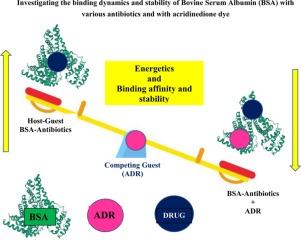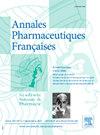Investigating the binding dynamics and stability of bovine serum albumin with antibiotics with acridinedione dye
IF 1.1
Q4 PHARMACOLOGY & PHARMACY
引用次数: 0
Abstract
Exploring the energetics and bimolecular interaction of bovine serum albumin (BSA) with various classes and generations of antibiotics in the absence and presence of a resorcinol based acridinedione dye (ADR1) were carried out. The binding stability of BSA-antibiotic complexes decreases on the introduction of ADR1 dye resulting in a positive value of free energy change, accompanied with several unfavourable interactions. Several polar amino acids contributed to the stability of the host-guest complex compared to that of non-polar amino acids, wherein BSA acts as the host, and antibiotics as the guest and ADR1 dye as the competing guest molecule. Hydrogen-bonding interactions govern the binding stability and energetics compared to that of hydrophobic interactions is elucidated in the present study.
Exploration de l’énergie et l’interaction bimoléculaire de l’albumine sérique bovine (BSA) avec diverses classes et générations d’antibiotiques en l’absence et en présence d’un colorant acridinedione à base de résorcinol (ADR1) ont été étudiées. La stabilité de la liaison des complexes BSA-antibiotiques diminue avec l’introduction du colorant ADR1, ce qui entraîne une valeur positive du changement d’énergie libre, accompagnée de plusieurs interactions défavorables. Plusieurs acides aminés polaires ont contribué à la stabilité du complexe hôte-invité par rapport à celle des acides aminés non polaires, dans lequel la BSA joue le rôle de l’hôte, les antibiotiques celui de l’invité et le colorant ADR1 celui de la molécule invitée concurrente. La présente étude a permis d’élucider le fait que les interactions par liaison hydrogène régissent la stabilité et l’énergie de la liaison par rapport aux interactions hydrophobes.

牛血清白蛋白与抗生素与吖啶二酮染料结合动力学及稳定性的研究。
在没有间苯二酚吖啶二酮染料(ADR1)和有间苯二酚吖啶二酮染料(ADR1)的情况下,研究人员探索了牛血清白蛋白(BSA)与各类和各代抗生素的能量和双分子相互作用。引入 ADR1 染料后,BSA-抗生素复合物的结合稳定性降低,导致自由能变化为正值,并伴随着几种不利的相互作用。与非极性氨基酸相比,几种极性氨基酸有助于提高宿主-客体复合物的稳定性,其中 BSA 作为宿主,抗生素作为客体,ADR1 染料作为竞争客体分子。与疏水相互作用相比,本研究阐明了氢键相互作用对结合稳定性和能量的影响。
本文章由计算机程序翻译,如有差异,请以英文原文为准。
求助全文
约1分钟内获得全文
求助全文
来源期刊

Annales pharmaceutiques francaises
PHARMACOLOGY & PHARMACY-
CiteScore
1.70
自引率
7.70%
发文量
98
期刊介绍:
This journal proposes a scientific information validated and indexed to be informed about the last research works in all the domains interesting the pharmacy. The original works, general reviews, the focusing, the brief notes, subjected by the best academics and the professionals, propose a synthetic approach of the last progress accomplished in the concerned sectors. The thematic Sessions and the – life of the Academy – resume the communications which, presented in front of the national Academy of pharmacy, are in the heart of the current events.
 求助内容:
求助内容: 应助结果提醒方式:
应助结果提醒方式:


